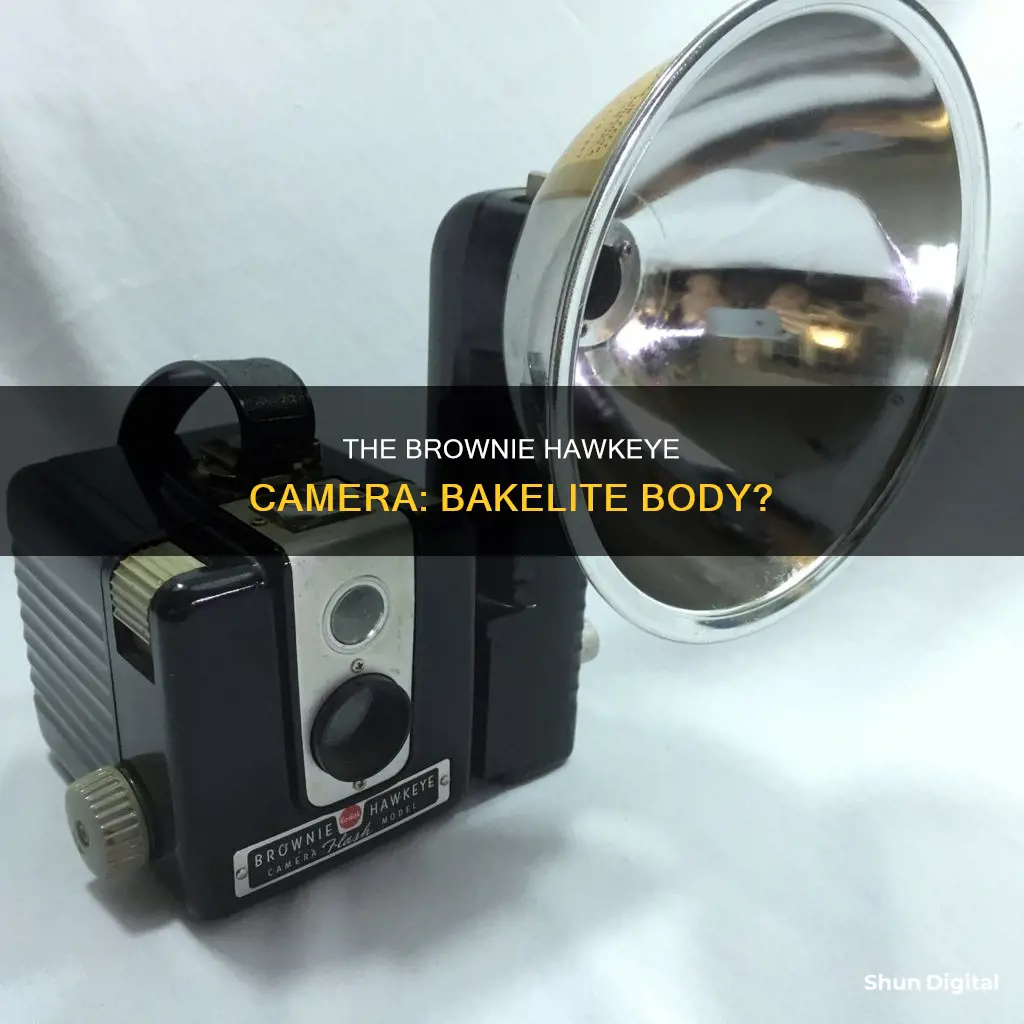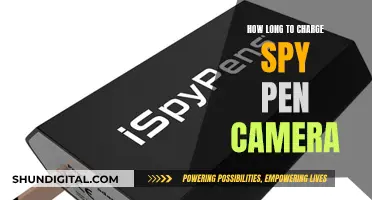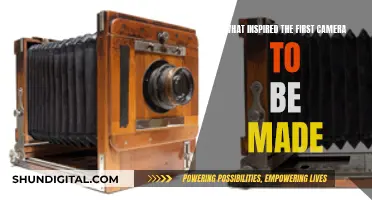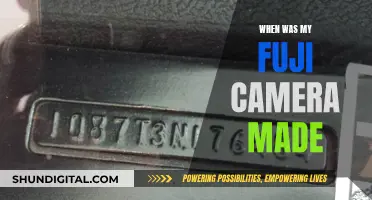
The Kodak Brownie Hawkeye, a popular camera for young photographers in the 1950s, is a Bakelite box camera made in the USA and France by Kodak between 1949 and 1961. It is a true classic, with its Art Deco styling and simplicity. The Brownie Hawkeye is a near-cubic brick of hard plastic, with a lens at the front and a button on the side.
| Characteristics | Values |
|---|---|
| Production Years | 1949-1961 |
| Original Price | $5.50 for non-flash models and $7.00 for flash models |
| Today's Price | $20 to $50 depending on condition and accessories |
| Film Type | 620 (or 120 with some modifications) |
| Lens | 81mm Single Element Miniscus Lens |
| Fixed Focal Range | 10' to Infinity |
| Shutter Speed | 1/30th of a second with an aperture around f/15 |
| Multiple Exposure Prevention | None |
| Manufacturer | Kodak |
| Place of Manufacture | Rochester, NY, USA |
| Material | Bakelite |
What You'll Learn

The Brownie Hawkeye was made from Bakelite
The Brownie Hawkeye is a classic camera that visually defines an era with its Art Deco styling and simplicity. It was popular among young photographers in the 1950s due to its low price of $5.50 for the non-flash model and $7.00 for the flash model. The camera takes 12 6x6cm images on 620 film and has a brilliant waist-level viewfinder. The lens, which is around 80mm, focuses from 5 feet to infinity, although some believe the true range is 10 feet or more. The shutter speed is approximately 1/30th of a second, with an aperture of around f/15. This means that the photographer needs to hold the camera very steadily while taking a shot.
The Brownie Hawkeye was originally released as a non-flash model, but an upgraded "Flash Model" was introduced in 1950. This new model was capable of pairing with many of the Kodak pin and screw-type flashes. The flash model was manufactured until July 1961 and was recognised as one of the most popular Brownie cameras ever made. It is still extremely popular with film photographers today due to its low price, ease of disassembly for cleaning, and ability to accept 120 film without respooling.
Launching Images in Camera Raw: A Step-by-Step Guide
You may want to see also

It was designed by Arthur Hunt Crapsey Jr
The Kodak Brownie Hawkeye camera, a much-loved and iconic piece of equipment, was designed by Arthur Hunt Crapsey Jr. The camera, with its moulded Bakelite body, was produced between 1949 and 1961. It was designed to be easy to use, with a shutter button and advance knob on one side, and an instant-to-bulb switch on the other. Crapsey Jr. was a talented designer who also created many other popular Kodak cameras, including the Kodak Brownie Bull's-Eye and the Kodak Brownie Star series.
The Brownie Hawkeye was a popular choice for young photographers in the 1950s due to its affordability and simplicity. It was one of the cameras that visually defined an era with its Art Deco styling. The camera's compact, box-shaped design featured a carrying handle on top and a winding knob to the photographer's right. It took 12 6x6cm images on 620 film and was known for its brilliant waist-level viewfinder, which provided a decent preview of the framing.
The Brownie Hawkeye was originally released as a non-flash model, with the flash model being introduced in 1950. The flash model was capable of accepting a wide range of Kodak pin and screw flash attachments. The camera was manufactured in both the USA and France, with the French version being called the "Brownie Flash". The original non-flash model was priced at $5.50, while the flash model was $7.00.
Arthur Hunt Crapsey Jr.'s design has stood the test of time, and the Kodak Brownie Hawkeye remains a beloved and sought-after camera by photographers even today. Its simplicity, ease of use, and the beautiful images it captures continue to make it a popular choice for film enthusiasts.
AGS Mode Camera Stopped: What's the Fix?
You may want to see also

It was produced from 1949 to 1961
The Kodak Brownie Hawkeye camera was produced from May 1949 to July 1961. The original non-flash model was introduced in May 1949 and discontinued in November 1951. The flash model was introduced in September 1950 and remained in production until July 1961.
The Brownie Hawkeye was a popular camera for young photographers in the 1950s. It was originally priced at $5.50 for the non-flash model and $7.00 for the flash model. It was manufactured in the USA and France by Kodak.
The camera is compact and box-shaped, with a carrying handle on top and a winding knob on the right side. It has a moulded bakelite body and uses a brilliant viewfinder. The design is a throw-back to the Art Deco era of the 1920s, with clean minimalist fluting on the sides and an attractively designed front.
Topping Off Camera Batteries: Is It Safe?
You may want to see also

It was a popular camera for young photographers
The Brownie Hawkeye was a popular camera for young photographers in the 1950s. It was originally priced at $5.50 for non-flash models and $7.00 for flash models. Kodak made and sold millions of them, and they have become an American icon. The Brownie Hawkeye is cheap, easy to use, and takes good photos. It is also compact and has a simple design, with a shutter button and advance knob on one side and a switch for instant to bulb on the other. It has a brilliant waist-level viewfinder, a rotary shutter, and a fixed-speed of approximately 1/30th-1/50th of a second. The Brownie Hawkeye is a true classic that visually defines an era with its Art Deco styling and simplicity.
Finding Dehaze in Camera Raw: A Quick Guide
You may want to see also

It was cheap and easy to use
The Brownie Hawkeye camera was made of Bakelite, a material that was cheap and easy to use. Bakelite is a synthetic plastic, the first of its kind, that could be moulded and hardened into any shape. This made it perfect for mass-producing a camera that was affordable and accessible to all.
The Brownie Hawkeye was introduced in 1949 and was in production until 1961. It was a simple camera with a lens on the front and a button on the side. It was a compact, box-shaped design with a carrying handle on top and a winding knob on the right-hand side for photographers. Its Art Deco aesthetic, with clean, minimalist fluting on the sides, was the work of designer Arthur H. Crapsey.
The camera was aimed at young photographers and originally retailed for $5.50 for the non-flash model and $7.00 for the flash model. It was a popular choice, and its low price point made it widely available. The Brownie Hawkeye is considered one of the cameras that visually define an era, with its Art Deco styling and simplicity.
The use of Bakelite in the camera's construction was a key factor in keeping costs down and making it easy to manufacture. Bakelite is known for its mouldability, and objects made from it tend to have a smooth surface that requires less finishing. This streamlined the production process and made it possible to create millions of parts quickly and inexpensively.
In addition to its affordability and ease of use, the Brownie Hawkeye was also well-loved for its brilliant viewfinder and ease of disassembly for cleaning. Its popularity endures even today among film photographers, who appreciate its low cost and adaptability for different types of film.
Extend Trail Camera Battery Life with These Tips
You may want to see also
Frequently asked questions
The Brownie Hawkeye camera is made of Bakelite.
The Brownie Hawkeye camera was made from 1949 to 1961.
The Brownie Hawkeye camera was made by Kodak.
The Brownie Hawkeye camera uses 620 film.







